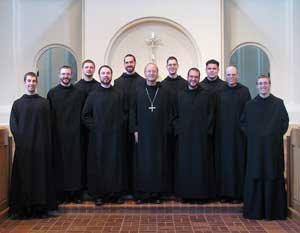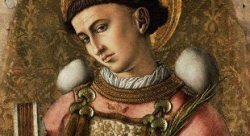
This is an excerpt of one of the last interviews with Mother Teresa conducted by Edward W. Desmond in 1989 for Time magazine. Excerpts from the interview appeared in Time magazine and the full text of the interview appeared in
The National Catholic Register.
Time: What did you do this morning?
Mother Teresa: Pray.
Time: When did you start?
Mother Teresa: Half-past four
Time: And after prayer
Mother Teresa: We try to pray through our work by doing it with Jesus, for Jesus, to Jesus. That helps us to put our whole heart and soul into doing it. The dying, the cripple, the mental, the unwanted, the unloved they are Jesus in disguise.
Time: People know you as a sort of religious social worker. Do they understand the spiritual basis of your work?
Mother Teresa: I don’t know. But I give them a chance to come and touch the poor. Everybody has to experience that. So many young people give up everything to do just that. This is something so completely unbelievable in the world, no? And yet it is wonderful. Our volunteers go back different people.
Time: Does the fact that you are a woman make your message more understandable?
Mother Teresa: I never think like that.
Time: But don’t you think the world responds better to a mother?
Mother Teresa: People are responding not because of me, but because of what we’re doing. Before, people were speaking much about the poor, but now more and more people are speaking to the poor. That’s the great difference. The work has created this. The presence of the poor is known now, especially the poorest of the poor, the unwanted, the loved, the uncared-for. Before, nobody bothered about the people in the street. We have picked up from the streets of Calcutta 54,000 people, and 23,000 something have died in that one room [at Kalighat].
Time: Why have you been so successful?
Mother Teresa: Jesus made Himself the bread of life to give us life. That’s where we begin the day, with Mass. And we end the day with Adoration of the Blessed Sacrament. I don’t think that I could do this work for even one week if I didn’t have four hours of prayer every day.
Time: Humble as you are, it must be an extraordinary thing to be a vehicle of God’s grace in the world.
Mother Teresa: But it is His work. I think God wants to show His greatness by using nothingness.
Time: You are nothingness?
Mother Teresa: I’m very sure of that.
Time: You feel you have no special qualities?
Mother Teresa: I don’t think so. I don’t claim anything of the work. It’s His work. I’m like a little pencil in His hand. That’s all. He does the thinking. He does the writing. The pencil has nothing to do it. The pencil has only to be allowed to be used. In human terms, the success of our work should not have happened, no? That is a sign that it’s His work, and that He is using others as instruments - all our Sisters. None of us could produce this. Yet see what He has done.
Time: What is God’s greatest gift to you?
Mother Teresa: The poor people.
Time: How are they a gift?
Mother Teresa: I have an opportunity to be with Jesus 24 hours a day.
Time: Here in Calcutta, have you created a real change?
Mother Teresa: I think so. People are aware of the presence and also many, many, many Hindu people share with us. They come and feed the people and they serve the people. Now we never see a person lying there in the street dying. It has created a worldwide awareness of the poor.
Time: Beyond showing the poor to the world, have you conveyed any message about how to work with the poor?
Mother Teresa: You must make them feel loved and wanted. They are Jesus for me. I believe in that much more than doing big things for them.
Time: What’s your greatest hope here in India?
Mother Teresa: To give Jesus to all.
Time: But you do not evangelize in the conventional sense of the term.
Mother Teresa: I’m evangelizing by my works of love.
Time: Is that the best way?
Mother Teresa: For us, yes. For somebody else, something else. I’m evangelizing the way God wants me to. Jesus said go and preach to all the nations. We are now in so many nations preaching the Gospel by our works of love. “By the love that you have for one another will they know you are my disciples.” That’s the preaching that we are doing, and I think that is more real.
Time: Friends of yours say that you are disappointed that your work has not brought more conversions in this great Hindu nation.
Mother Teresa: Missionaries don’t think of that. They only want to proclaim the Word of God. Numbers have nothing to do with it. But the people are putting prayer into action by coming and serving the people. Continually people are coming to feed and serve, so many, you go and see. Everywhere people are helping. We don’t know the future. But the door is already open to Christ. There may not be a big conversion like that, but we don’t know what is happening in the soul.
Time: What do you think of Hinduism?
Mother Teresa: I love all religions, but I am in love with my own. No discussion. That’s what we have to prove to them. Seeing what I do, they realize that I am in love with Jesus.
Time: And they should love Jesus too?
Mother Teresa: Naturally, if they want peace, if they want joy, let them find Jesus. If people become better Hindus, better Moslems, better Buddhists by our acts of love, then there is something else growing there. They come closer and closer to God. When they come closer, they have to choose.
Time: You and John Paul II, among other Church leaders, have spoken out against certain lifestyles in the West, against materialism and abortion. How alarmed are you?
Mother Teresa: I always say one thing: If a mother can kill her own child, then what is left of the West to be destroyed? It is difficult to explain , but it is just that.
Time: When you spoke at Harvard University a few years ago, you said abortion was a great evil and people booed. What did you think when people booed you?
Mother Teresa: I offered it to our Lord. It’s all for Him, no? I let Him say what He wants.
Time: But these people who booed you would say that they also only want the best for women?
Mother Teresa: That may be. But we must tell the truth.
Time: And that is?
Mother Teresa: We have no right to kill. Thou shalt not kill, a commandment of God. And still should we kill the helpless one, the little one? You see we get so excited because people are throwing bombs and so many are being killed. For the grown ups, there is so much excitement in the world. But that little one in the womb, not even a sound? He cannot even escape. That child is the poorest of the poor.
Time: Is materialism in the West an equally serious problem?
Mother Teresa: I don’t know. I have so many things to think about. I pray lots about that, but I am not occupied by that. Take our congregation for example, we have very little, so we have nothing to be preoccupied with. The more you have, the more you are occupied, the less you give. But the less you have the more free you are. Poverty for us is a freedom. It is not a mortification, a penance. It is joyful freedom. There is no television here, no this, no that. This is the only fan in the whole house. It doesn’t matter how hot it is, and it is for the guests. But we are perfectly happy.
Time: How do you find rich people then?
Mother Teresa: I find the rich much poorer. Sometimes they are more lonely inside. They are never satisfied. They always need something more. I don’t say all of them are like that. Everybody is not the same. I find that poverty hard to remove. The hunger for love is much more difficult to remove than the hunger for bread.
Time: What is the saddest place you’ve ever visited?
Mother Teresa: I don’t know. I can’t remember. It’s a sad thing to see people suffer., especially the broken family, unloved, uncared for. It’s a big sadness; it’s always the children who suffer most when there is no love in the family. That’s a terrible suffering. Very difficult because you can do nothing. That is the great poverty. You feel helpless. But if you pick up a person dying of hunger, you give him food and it is finished.
Time: Why has your order grown so quickly?
Mother Teresa: When I as young people why they want to join us, they say they want the life of prayer, the life of poverty and the life of service to the poorest of the poor. One very rich girl wrote to me and said for a very long time she had been longing to become a nun. When she met us, she said I won’t have to give up anything even if I give up everything. You see, that is the mentality of the young today. We have many vocations.
Time: There’s been some criticism of the very severe regimen under which you and your Sisters live.
Mother Teresa: We chose that. That is the difference between us and the poor. Because what will bring us closer to our poor people? How can we be truthful to them if we lead a different life? If we have everything possible that money can give, that the world can give, then what is our connection to the poor? What language will I speak to them? Now if the people tell me it is so hot, I can say you come and see my room.
Time: Just as hot?
Mother Teresa: Much hotter even, because there is a kitchen underneath. A man came and stayed here as a cook at the children’s home. He was rich before and became very poor. Lost everything. He came and said, “Mother Teresa, I cannot eat that food.” I said, “I am eating it every day.” He looked at me and said, “You eat it too? All right, I will eat it also.” And he left perfectly happy. Now if I could not tell him the truth, that man would have remained bitter. He would never have accepted his poverty. He would never have accepted to have that food when he was used to other kinds of food. That helped him to forgive, to forget.
Time: What’s the most joyful place that you have ever visited?
Mother Teresa: Kalighat. When the people die in peace, in the love of God, it is a wonderful thing. To see our poor people happy together with their families, these are beautiful things. The real poor know what is joy.
Time: There are people who would say that it’s an illusion to think of the poor as joyous, that they must be given housing, raised up.
Mother Teresa: The material is not the only thing that gives joy. Something greater than that, the deep sense of peace in the heart. They are content. That is the great difference between rich and poor.
Time: But what about those people who are oppressed? Who are taken advantage of?
Mother Teresa: There will always be people like that. That is why we must come and share the joy of loving with them.
Time: Should the Church’s role be just to make the poor as joyous in Christ as they can be made?
Mother Teresa: You and I, we are the Church, no? We have to share with our people. Suffering today is because people are hoarding, not giving, not sharing. Jesus made it very clear. Whatever you do to the least of my brethren, you do it to me. Give a glass of water, you give it to me. Receive a little child, you receive me. Clear.
Time: If you speak to a political leader who could do more for his people, do you tell him that he must do better?
Mother Teresa: I don’t say it like that. I say share the joy of loving with your people. Because a politician maybe cannot do the feeding as I do. But he should be clear in his mind to give proper rules and proper regulations to help his people.
Time: It is my job to keep politicians honest, and your job to share joy with the poor.
Mother Teresa: Exactly. And it is to be for the good of the people and the glory of God. This will be really fruitful. Like a man says to me that you are spoiling the people by giving them fish to eat. You have to give them a rod to catch the fish. And I said my people cannot even stand, still less hold a rod. But I will give them the fish to eat, and when they are strong enough, I will hand them over to you. And you give them the rod to catch the fish. That is a beautiful combination, no?
Time: Feminist Catholic nuns sometimes say that you should pour your energy into getting the Vatican to ordain women.
Mother Teresa: That does not touch me.
Time: What do you think of the feminist movement among nuns in the West?
Mother Teresa: I think we should be more busy with our Lord than with all that, more busy with Jesus and proclaiming His Word. What a woman can give, no man can give. That is why God has created them separately. Nuns, women, any woman. Woman is created to be the heart of the family, the heart of love. If we miss that, we miss everything. They give that love in the family or they give it in service, that is what their creation is for.
Time: The world wants to know more about you.
Mother Teresa: No, no. Let them come to know the poor. I want them to love the poor. I want them to try to find the poor in their own families first, to bring peace and joy and love in the family first.
Time: Malcolm Muggeridge once said that if you had not become a Sister and not found Christ’s love, you would be a very hard woman. Do you think that is true?
Mother Teresa: I don’t know. I have no time to think about these things.
Time: People who work with you say that you are unstoppable. You always get what you want.
Mother Teresa: That’s right. All for Jesus.
Time: And if they have a problem with that?
Mother Teresa: For example, I went to a person recently who would not give me what I needed. I said God bless you, and I went on. He called me back and said what would you say if I give you that thing. I said I will give you a “God bless you” and a big smile. That is all. So he said then come, I will give it to you. We must live the simplicity of the Gospel.
Time: You once met Haile Mariam Mengistu, the much feared communist leader of Ethiopia and an avowed atheist. You asked him if he said his prayers. Why did you risk that?
Mother Teresa: He is one more child of God. When I went to China, one of the top officials asked me, “What is a communist to you?” I said, “A child of God.” Then the next morning the newspapers reported that Mother Teresa said communists are children of God. I was happy because after a long, long time the name God was printed in the papers in China. Beautiful.
Time: Are you ever been afraid?
Mother Teresa: No, I am only afraid of offending God. We are all human beings, that is our weakness, no? The devil would do anything to destroy us, to take us away from Jesus.
Time: Where do you see the devil at work?
Mother Teresa: Everywhere. When a person is longing to come closer to God he puts temptation in the way to destroy the desire. Sin comes everywhere, in the best of places.
Time: What is your greatest fear?
Mother Teresa: I have Jesus, I have no fear.
Time: What is your greatest disappointment?
Mother Teresa: I do the will of God, no? In doing the will of God there is no disappointment.
Time: Do your work and spiritual life become easier with time?
Mother Teresa: Yes, the closer we come to Jesus, the more we become the work. Because you know to whom you are doing it, with whom you are doing it and for whom you are doing it. That is very clear. That is why we need a clean heart to see God.
Time: What are your plans for the future?
Mother Teresa: I just take one day. Yesterday is gone. Tomorrow has not come. We have only today to love Jesus.
Time: And the future of the order?
Mother Teresa: It is His concern.
 From the Catholic Key
From the Catholic Key








































